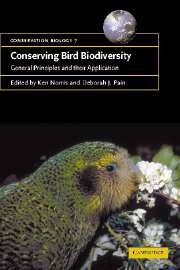Book contents
- Frontmatter
- Contents
- List of contributors
- Preface
- 1 Biodiversity – evolution, species, genes
- 2 Why conserve bird diversity?
- 3 Mapping and monitoring bird populations: their conservation uses
- 4 Priority-setting in species conservation
- 5 Selecting sites for conservation
- 6 Critically endangered bird populations and their management
- 7 Diagnosing causes of population declines and selecting remedial actions
- 8 Outside the reserve: pandemic threats to bird biodiversity
- 9 Predicting the impact of environmental change
- 10 Fragmentation, habitat loss and landscape management
- 11 The interface between research, education and training
- 12 Conservation policies and programmes affecting birds
- References
- Index
2 - Why conserve bird diversity?
Published online by Cambridge University Press: 10 December 2009
- Frontmatter
- Contents
- List of contributors
- Preface
- 1 Biodiversity – evolution, species, genes
- 2 Why conserve bird diversity?
- 3 Mapping and monitoring bird populations: their conservation uses
- 4 Priority-setting in species conservation
- 5 Selecting sites for conservation
- 6 Critically endangered bird populations and their management
- 7 Diagnosing causes of population declines and selecting remedial actions
- 8 Outside the reserve: pandemic threats to bird biodiversity
- 9 Predicting the impact of environmental change
- 10 Fragmentation, habitat loss and landscape management
- 11 The interface between research, education and training
- 12 Conservation policies and programmes affecting birds
- References
- Index
Summary
REASONS FOR CONSERVATION
To the reader of this chapter it probably seems self-evident why we should conserve birds. Birds are part of biodiversity and their widespread declines indicate a fundamental malaise in the way that humans treat the Earth. It may not be obvious in the daily lives of many city dwellers, but we are and remain part of biodiversity ourselves. We eat it, we make and trade goods from it and we depend on its services in many inescapable ways. There are strong utilitarian arguments for conservation. If we do not act to stem the current crisis now, we will pay later, and we may have to pay very heavily. Our unique cultural and technical development has tended to separate us from some obvious truths. We have altered a huge part of our natural life support system. With our vast numbers, we appropriate a large and growing fraction of finite natural resources. Modern transport and communications have enlarged the distance over which every one of us has impact. As a result, the social and environmental impacts of our resource use and abuse are remote from the daily lives of most of us, especially the more affluent. It appears easy and attractive to believe that there will be technical solutions to these ills. Meanwhile we can afford to continue business as usual.
- Type
- Chapter
- Information
- Conserving Bird BiodiversityGeneral Principles and their Application, pp. 20 - 33Publisher: Cambridge University PressPrint publication year: 2002
- 5
- Cited by

